northwest corner of Wyoming
NPS Website; Local Website; USGS Website; Xanterra Parks and Resorts Site
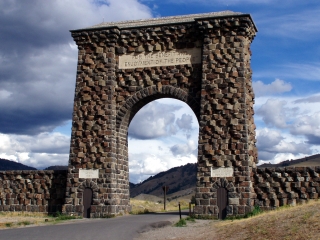 Yellowstone National Park is a diverse natural wonderland roughly twice the size of the state of Delaware. Because of the Park’s immense size and staggering variety of experiences, we have broken our Yellowstone reviews into three separate entries: the North, Central and South.
Yellowstone National Park is a diverse natural wonderland roughly twice the size of the state of Delaware. Because of the Park’s immense size and staggering variety of experiences, we have broken our Yellowstone reviews into three separate entries: the North, Central and South.WHAT IS IT?
Yellowstone’s northern tier is the portion of the Park that exists outside of the Yellowstone caldera and, as a result, enjoys a much greater variety of plant and animal life. Herds of bison roam the expanses of the Lamar Valley, joined by wolf packs, pronghorns and elk.
The caldera is a remnant of tremendous supervolcanic explosions. It is the depression left behind by the reverse impact of the supervolcano’s debris. The supervolcanoes’ still-active magnetic heat is partially responsible for the geyser fields and hydrothermal activity.
The north is home to most of Yellowstone’s easily accessible mountain peaks and is at a higher elevation than the caldera zone. Nearly all of the Park’s bighorn sheep live in the alpine terrain just south of Tower Fall around Mount Washburn.
The most famous attraction in Yellowstone’s North is Mammoth Hot Springs, one of the few terraced calcium carbonite formations in the world. The extensive system of multihued cascading hot springs is very similar in geological development and appearance to the interior of spectacular caverns like Carlsbad and Mammoth. At Yellowstone, nature has been turned inside out. Mammoth Hot Springs exist outside the caldera and bubble and flow from the heat generated by the slow northeastward movement of the Jackson Hot Spot; the same Hot Spot that ten of thousands of years ago created the lava fields at Craters of the Moon NM and the rich potato-growing soils of southern Idaho.
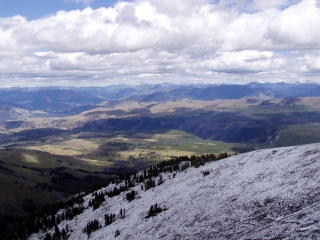 BEAUTY (10/10)
BEAUTY (10/10)We found the North to be the most beautiful part of the Park, especially the Lamar Valley. More wildlife, more diversity, higher mountains and supernatural hot springs.
HISTORICAL INTEREST (10/10)
In 1872, Yellowstone became the world’s first National Park, the first time land had ever been set aside for public use. Yellowstone NP served as the initial model for the conservation of our precious landscape.
The area also boasts of a long and important Native American history. The obsidian found throughout the Park was the most widely traded good in North American for thousands of years. Indians ranging throughout the continent fashioned arrowheads almost exclusively from materials mined here.
CROWDS (9/10)
Everybody in the North was so happy. We encountered so many different and excited people many of whom gave us indelible memories. There is much space and a wide array of activities nearby: fly fishing, auto touring, wildlife watching, hikes along paved walkways and boardwalks, moderate hikes through valleys, strenuous hikes up mountains and little used backcountry trails. As soon as you venture away from the road, you see few people. The Beaver Ponds Loop Trail begins and ends in the heavily trafficked Mammoth Hot Springs area. Once we started hiking, we saw more elk than humans. Solitude is possible but hardly necessary given the giddy joy on all faces.
EASE OF USE/ACCESS (3/5)
North Yellowstone can be accessed from Interstate 90 in Montana via U.S. Route 89 and U.S. Route 212.
Route 89 travels 58 miles south from Livingston, MT to Mammoth Hot Springs. This scenic route follows the Yellowstone River the whole way and enters the Park underneath the imposing stone Roosevelt arch at the Park’s North Entrance.
Route 212, the Beartooth Highway, is a 124 mile drive from Billings, MT. It is one of America’s most scenic drives. Starting in Red Lodge, MT, it climbs tremendous heights, eventually crossing the Wyoming border at the 10,947 Beartooth Pass. The road passes through the Custer and Shoshone National Forests and is every bit as stunning as the Going-to-the-Sun Road at Glacier NP. The Beartooth Highway is under construction and is often closed due to weather conditions.
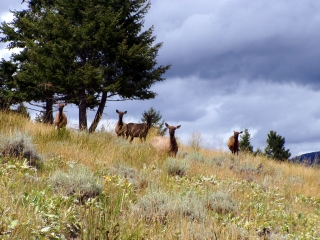 Route 212 enters the Park at Silver Gate, MT, the Northeast Entrance, and travels 29 miles through the Lamar Valley before reaching the Yellowstone Figure Eight Driving Loop at Tower-Roosevelt. The Lamar Valley is home to much of the Park’s wildlife and is seldom traveled because it is outside the standard auto tour loop.
Route 212 enters the Park at Silver Gate, MT, the Northeast Entrance, and travels 29 miles through the Lamar Valley before reaching the Yellowstone Figure Eight Driving Loop at Tower-Roosevelt. The Lamar Valley is home to much of the Park’s wildlife and is seldom traveled because it is outside the standard auto tour loop.The North section of Yellowstone NP forms the П portion of the Figure Eight Driving Loop.
The stretch of the Figure Eight between Tower-Roosevelt and Canyon Village is closed for construction during all of 2004. It is scheduled to open sometime in 2005.
Once you get to Yellowstone, the Park is very accessible. Numerous pull offs and picnic areas allow the motorist to see oodles of wildlife. Mammoth Hot Springs can be closely viewed due to an extensive boardwalk system that is constantly being rebuilt. Yellowstone NP makes incredible efforts to ensure the visitor an optimum experience.
CONCESSIONS/BOOKSTORE (5/5)
The Yellowstone Association runs eight different bookstores in the Park. They are a non-profit organization that has served visitors since 1933. They do an outstanding job. Check out the online bookstore. There is an even better selection at the Park. They operate one store in the North, at the Mammoth Hot Springs Visitor Center.
There are two full-service dining rooms in the North, one at the Roosevelt Lodge and one at the Mammoth Hot Springs Lodge. We holed up for hours at the Terrace Grill Dining Room near the Lodge and worked on our computers. As an extra bonus, there is full Verizon cellular service in the North. No such luck anywhere else in the Park. We believe Sprint service is available in the Central and South.
There are two gift stores at Mammoth we believe run by different companies. They both have a good, if not overpriced, selection of stuffed animals and knick-knacks. There is a marked difference in the quality of ice cream and coffee served at the two. Scope them out and make the right decision.
COSTS (3/5)
A $20 vehicle entrance fee is good for a week’s stay at both Yellowstone NP and Grand Teton NP, an incredible bargain given the sheer amount of things to see in the Parks’ combined 2.5 million acres. Entry is free with the National Parks Pass.
There are five campgrounds, a total of 237 campsites, in the North. They are all run by the National Park Service and are available only on a first-come, first-serve basis. Mammoth campground is Yellowstone’s only year-round campsite. Mammoth costs $14. The other four cost $12. These are some of the Park’s most popular car camping sites and often fill up early.
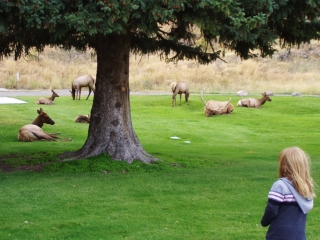 There are Xanterra-run lodges at both Roosevelt and Mammoth. Cabins are available at Roosevelt for $56 w/o bath and $91 with. Cabins and Hotel rooms are offered at Mammoth with prices ranging between $64 and $291.
There are Xanterra-run lodges at both Roosevelt and Mammoth. Cabins are available at Roosevelt for $56 w/o bath and $91 with. Cabins and Hotel rooms are offered at Mammoth with prices ranging between $64 and $291.There is a wide range of overnight possibilities, none of which is exorbitantly priced. We loved the NPS campsites in the North.
Backcountry camping is free. There is a $20 per trip reservation fee if you wish to ensure your space ahead of time.
RANGER/GUIDE TO TOURIST RATIO (5/5)
Rangers are everywhere and they do a terrific job. Amidst the madness of the heavily touristed Mammoth Hot Springs Visitor Center, Gab received day hike brochures covering six of the Park’s major areas. The Ranger took the time to pick out her favorite hikes on all six and explain that she has made a concerted effort to try them all. Her picks were all stellar. We treasured her advice.
We encountered another Ranger at the Tower Fall overlook. He was just there to answer any questions. We told him that we wanted to see bighorn sheep and he told us what to do: climb Mount Washburn. So we did. Alas, no bighorns, but plenty of tracks and an astounding view of the entire caldera from 10,243 feet up. What a day.
There is a Ranger Station at Tower-Roosevelt and a Yellowstone Association Institute in the Lamar Valley. The Institute has no traditional visitor services, but in the mornings, a zoologist Ranger is often posted along the Lamar Valley road spotting wolves. Another Ranger told us that the zoologist loves relating to visitors the soap opera saga that is the life of the wolf pack.
In-depth educational vacations are offered at the Yellowstone Association Institute that focus on, among other things, park ecology, nature writing and wolf biology. Sign us up for the wolf biology class. That sounds incredible.
Everyday during the summer, five Ranger-led talks take place at Mammoth. A strenuous Ranger Adventure hike is available for a $15 dollar fee.
TOURS/CLASSES (9/10)
Yellowstone NP offers so many Ranger Programs that it distributes an 8-page newspaper handout to everyone entering the park regarding these tours. The number of programs understandably taper severely as the seasons change and the weather turns nasty.
We took the Mammoth Hot Spring Terrace Walk during what was technically summer. The cold rains came and our delightful Ranger, the same woman who helped Gab with the day hike selection, immediately made sure to put the plastic weather guard on her signature straw hat. The weather did not deter our terrific tour, but it was nice to linger in the warm steam of the Hot Springs.
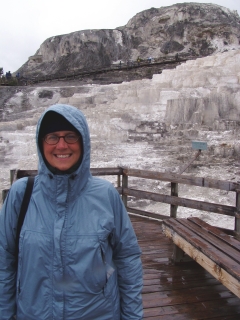 We gained a good understanding of the tricky geological notions of calderas, supervolcanoes, hot spots and travertine formations. Her talk was a remarkable introduction to the mystical steaming world of Yellowstone. You should take a geology-related Ranger tour at the Park. We gained appreciation for the uniqueness of the landscape we were standing above. The talks provided a much better explanation that the geothermal-related Museum at the Norris Geyser Basin and Rangers are there to answer questions and clear up the inevitable confusion.
We gained a good understanding of the tricky geological notions of calderas, supervolcanoes, hot spots and travertine formations. Her talk was a remarkable introduction to the mystical steaming world of Yellowstone. You should take a geology-related Ranger tour at the Park. We gained appreciation for the uniqueness of the landscape we were standing above. The talks provided a much better explanation that the geothermal-related Museum at the Norris Geyser Basin and Rangers are there to answer questions and clear up the inevitable confusion.In the summer, Ranger-led walking tours occur daily around the Hot Springs area buildings, once Fort Yellowstone. The Albright Visitor Center is, in fact, located in the former bachelor officer’s quarters building. The Visitor Center theme is the History of Yellowstone. Displays cover Native American life and trade, the mountain man, the former Fort and the early Park Service time here. Admittedly, we hurried through this section, eager to see the Museum’s other two exhibit themes.
Gab rushed upstairs to see the stuffed and posed predators while Michael ducked around the corner to see the Thomas Moran watercolors and sketches as well as the William Henry Jackson black and white photographs. We were both under whelmed and a bit disappointed. The small Thomas Moran sketches on display do not capture the essence of his larger than life landscapes. His colorful depictions of the area take up half an entire wall at the Metropolitan Museum of Art. That’s the west, that’s Yellowstone. Larger than life. A dozen or so small reproduction does not capture Moran. As for the animals, we decided we would much rather see live versions.
The Yellowstone Association provides glossy, color self-guided trail booklets for nearly every sub-section of the Park. The guides are terrific and available for a donation of $0.50. You can also use the trail guide free of charge and return it to the trailhead box when you are done. We bought some and recycled others. Few other people used the guides, which is a shame. They are packed full of information and done for you. Free mimeographed day-hike pamphlets are available at every Ranger Station. Yellowstone NP has a wealth of valuable information ready to dispense for free. Take advantage of their terrific service. Few parks do such a great job.
FUN (10/10)
The Mammoth campground hosts were greeted by us every morning as we extended our stay “just one more day”. This happened three times. Rangers told us that the best hikes in the Park are in the North. We have no reason to argue.
The North also felt less crowded and more off the beaten path. The outsourced lodges, campsites and gift stores have less of a presence. If it hadn’t been for the crazy weather we don’t know if we ever would have left.
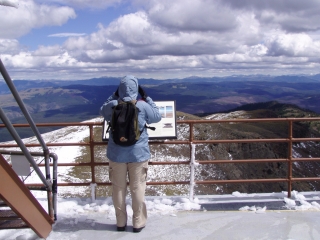 WOULD WE RECOMMEND? (10/10)
WOULD WE RECOMMEND? (10/10)Oh my heavens yes. Yellowstone NP is the classic National Parks destination. Much to our delight the Museums, tours, staffing and bookstores are all equal to the stunning natural surroundings. Everything here is done right. We loved the North and would love to spend days, if not weeks, in the backcountry here sometime soon.
TOTAL 74/80
www.usa-c2c.com
© 2004-06